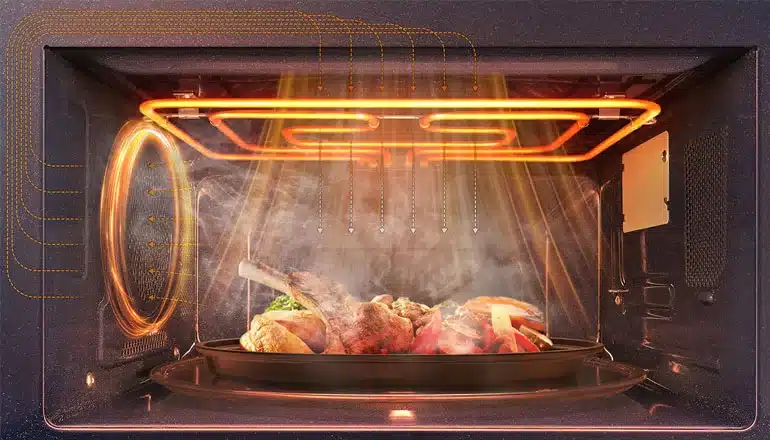When it comes to ovens, the choice between a commercial oven and a home oven goes beyond just their size and capacity. One of the most significant distinctions lies in their temperature capabilities, but that’s not the only difference. In this comprehensive comparison, we’ll explore the variations between these two types of ovens in terms of temperature range, size, construction, and applications, helping you make an informed decision when choosing the right oven for your needs.
Temperature Range: Commercial ovens are known for their wide temperature range, often reaching up to a blistering 800°F (427°C). This high-temperature capacity is ideal for tasks such as pizza making, where achieving the perfect crust is crucial. On the other hand, home ovens generally have a temperature range of 180°F to 550°F (82°C to 288°C), which suits most baking needs.
Size and Capacity: Commercial ovens are typically larger and have a much higher capacity. They are designed to handle bulk cooking, making them a staple in professional kitchens. In contrast, home ovens are smaller and cater to the needs of individual households.
Construction and Durability: Commercial ovens are built to withstand heavy daily use in busy kitchens. They feature robust construction, often with stainless steel components, ensuring durability. Home ovens, while well-constructed, may not be as rugged as their commercial counterparts.
Applications: Commercial ovens are versatile and can handle a wide range of cooking methods, including baking, roasting, broiling, and more. Home ovens are designed primarily for baking and roasting and may lack some advanced features found in commercial ovens.
Cost: Commercial ovens are significantly more expensive than home ovens. The cost includes not only the oven itself but also installation and operational expenses, making them a substantial investment. Home ovens are more budget-friendly and cost-effective for individual consumers.
The following table provides a clearer comparison of the differences between commercial ovens and household ovens.
1. Size and Capacity:
Commercial Ovens:
- Size: Commercial ovens, on average, range from 20 to 60 cubic feet, offering substantial interior space.
- Capacity: Able to handle multiple trays simultaneously, catering to the high-volume demands of commercial kitchens.
Home Ovens:
- Size: Typically compact, home ovens range from 2 to 6 cubic feet.
- Capacity: Suited for standard household needs, accommodating one or two trays at a time.
Table 1: Size and Capacity Comparison
| Oven Type | Size Range | Capacity |
|---|---|---|
| Commercial Oven | 20 – 60 cubic feet | Multiple trays for high-volume use |
| Home Oven | 2 – 6 cubic feet | One or two trays for home cooking |
2. Power and Speed:
Commercial Ovens:
- Power: Commercial ovens operate at higher voltage and wattage for rapid preheating and cooking.
- Speed: Efficient and designed for continuous use, minimizing downtime.
Home Ovens:
- Power: Home ovens operate at standard household voltage and wattage.
- Speed: Slightly longer preheating and cooking times due to lower power levels.
Table 2: Power and Speed Overview
| Oven Type | Power Characteristics | Speed of Operation |
|---|---|---|
| Commercial Oven | High voltage and wattage | Rapid preheating and cooking for efficiency |
| Home Oven | Standard household voltage/wattage | Slightly longer times for intermittent use |
3. Durability and Construction:
Commercial Ovens:
- Durability: Constructed with heavy-duty materials to endure constant use.
- Construction: Robust design to withstand high temperatures and continuous operation.
Home Ovens:
- Durability: Designed for intermittent use, offering durability for standard household needs.
- Construction: Sturdy construction but not as heavy-duty as commercial ovens.
Table 3: Durability and Construction Overview
| Oven Type | Durability | Construction |
|---|---|---|
| Commercial Oven | Built for constant use | Heavy-duty materials for endurance |
| Home Oven | Suited for intermittent use | Sturdy construction for household requirements |
4. Precision and Control:
Commercial Ovens:
- Precision: Advanced temperature control systems for precise regulation of heat.
- Control: Enables chefs to achieve specific cooking outcomes with accuracy.
Home Ovens:
- Precision: Offers temperature control but may lack the precision of commercial ovens.
- Control: Adequate for a range of home-cooked meals without the need for intricate temperature adjustments.
Table 4: Precision and Control Features
| Oven Type | Precision | Control |
|---|---|---|
| Commercial Oven | Advanced temperature control systems | Enables precise cooking for chefs |
| Home Oven | Offers temperature control | Adequate control for varied home cooking |
5. Cost:
Commercial Ovens:
- Cost: Higher upfront investment due to size, power, and advanced features.
- Justification: Catering to the efficiency demands of commercial kitchens.
Home Ovens:
- Cost: More budget-friendly for the average homeowner.
- Justification: Satisfies smaller-scale cooking and baking needs.
Table 5: Cost Considerations
| Oven Type | Cost | Justification |
|---|---|---|
| Commercial Oven | Higher upfront investment | Efficiency for high-volume commercial use |
| Home Oven | Budget-friendly for home use | Suited for smaller-scale household cooking |
Conclusion:
Choosing between a commercial oven and a home oven depends on your specific needs. If you’re running a professional kitchen or need to prepare large quantities of food regularly, a commercial oven is the way to go. For typical household cooking and baking tasks, a home oven is more practical and cost-effective.
Make your decision based on your culinary requirements, available space, and budget, and consider the multiple factors that set commercial and home ovens apart.

